We have covered take-down and folding 22 LR rifles suitable for a bug-out bag, camping gear duffle bag, or backpack, several times, starting in the August 2012 issue to the latest in the September 2020 issue. After the 2020 article, we received a bunch of e-mails about including the Henry AR-7 and Chiappa Little Badger. There were also a few e-mails about the Marlin Papoose, a take-down 22 LR first introduced in 1986.
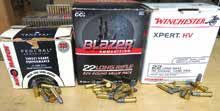
So we are back with these three additional rifles that all offer light weight and the ability to be disassembled or be collapsed and stowed in a smaller package. The 22 LR rifle can be made lightweight, and it allows you to easily carry more rounds compared to centerfire-caliber cartridges. A rimfire also can be used to hunt and in self defense, and the 22 LR round offers minimal recoil and low muzzle blast. This time, these rifles are either a take-down style (AR-7 and Papoose) or a folder (Little Badger) for smaller storage. We again looked at ease of disassembling or collapsing the rifle, ease of use, ease of loading the magazine, weight, ease in field stripping for cleaning, and finally accuracy.
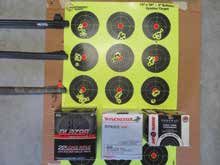
First the similarities. They are all lightweight, weighing in around 3 pounds. The Marlin came with a padded, rectangular nylon bag, which was the largest storage method. The Chiappa comes with a thin unpadded triangular pouch shaped like a pizza slice. The Henry doesn’t need a bag, case, or a pouch, because all its components fit inside the rifle stock. With all the components nested inside the stock and the butt pad as a lid, the AR-7 will float. We like the way the AR-7 stows in its own stock like Tupperware. All three were fast to get into action, with the Chiappa being the fastest. However, a follow-up shot with it was obviously slow. The Marlin and Henry required lots of tightening down of barrel nuts, which made us feel like a spy in an old movie as we assembled the rifles. The Henry took the longest to get into action because the action needs to screwed into the stock and then the barrel screwed on to the action. With the Marlin, all you need to do is screw in the barrel. They were also accurate at 15 yards, with many groups resembling one ragged hole. These rifles performed without exception. The cost of the rifles ranged from about $179 up to $457.
How We Tested
Though we collected range data using iron sights, you can mount an optic or red dot on any of these rifles. When you do that, the gun becomes less of a survival rifle since neither the Henry nor the Chiappa can be stowed as originally designed. You could add a scope to the Marlin since the case is so large. We did remove the barrel after extended shooting to see how hot they were and if the threads on the locking nuts seized, but we found we could disassemble and reassemble with no issues. Sure, the barrels were warm, but they were easier to manipulate with bare hands. Also, there was no point-of-impact shift in the Marlin and the Henry between assemblies because the sights are attached to the barrels.
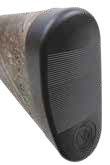
We tried three different bullet weights: 36-grain Winchester Xpert HV, 38-grain CCI Blazer, and 40-grain Federal AutoMatch Target. We tested accuracy at 15 yards, and as if we were in the field, we used our range bag as a rest and found all rifles to be quite accurate. In fact, we shot many groups that had all the holes touching. We also fired the rifles off hand at 8-inch paper plates at 25 yards. We fired for speed with the Marlin and Henry, and we fired as fast as we could with the single-shot Chiappa. Long story short, the paper plates did not pose a threat. The aperture sights on the Chiappa and Henry were fast on target, and the U-notch steel rear and ramp front sights on the Marlin were a hair slower. We had one failure to feed with the Marlin at the onset, but both semi-autos chewed through ammo. We also mixed up cartridges in the magazines to see if we could trip them up. Both the Henry and Marlin performed flawlessly.
Because these rifles are designed to be disassembled for compact storage, there are some idiosyncrasies. We think any one of these would be a good bug out/survival rifle, but the Henry would be Our Pick. Here’s why.
Gun Tests Grade: A-
$457
The Model 70P Papoose had a following among campers and survivalists a generation ago. It was introduced in 1986 and was produced until 1994. Our hope is Ruger resurrects this handy little rifle. Similar to the Savage Model 64 Takedown we reviewed a few issues back, the Papoose takes a minimalist approach that breaks down a rifle into two pieces: A stocked receiver and a barrel with sights. Overall length is 35.5 inches, and weight is 3.3 pounds. Our used sample came in a padded canvas case with carrying handles, a spanner wrench, and one seven-round magazine.
| Action Type | Semi-auto, hammer fired |
| Overall Length | 35.2 in. |
| Overall Length Disassembled | 20.0 in. |
| Barrel Length/Twist Rate | 16.2 in.; 1:16 RH twist |
| Overall Height | 7.1 in. |
| Weight Unloaded | 3.2 lbs. |
| Weight Loaded | 4.0 lbs. |
| Sight Radius | 12.2 in. |
| Barrel | Blued steel |
| Receiver | Matte black alloy, grooved top for optic |
| Buttstock | Smooth wood, checkered polymer buttpad |
| Buttstock LOP | 13.5 in. |
| Magazine | (1) 7-round detachable box |
| Front Sight | Steel ramp |
| Rear Sight | Adj. notch |
| Trigger-Pull Weight | 5.8 lbs. |
| Safety | Manual hammer block |
| Warranty | None, pre-Ruger acquisition |
| Telephone (Ruger) | (336) 949-5200 |
| Website | MarlinFirearms.com |
| Made In | USA |
The Papoose uses a simple blowback action that is based on the Marlin 60, a solid and proven design with more than 11 million rifles built since it debuted in 1960. The Model 70P has a manual bolt hold-open feature that is activated by pushing the charging handle inward toward the gun when it is fully retracted. To close the bolt, just pull the charging handle out, and the bolt flies forward. The manual safety blocks the trigger and is located just aft of the trigger and is easily manipulated by right-hand shooters.
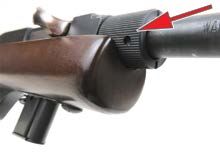
Our sample sported a smooth wood stock and blued metal work. The buttpad was checkered plastic with the Marlin logo. The bolt and bolt handle were bright stainless steel. The trigger guard was black plastic, and the magazine well was metal. A stamped-steel magazine latch locks the seven-round steel magazine in place. The receiver is metal and is grooved on the top for mounting an optic.
The barrel assembly consisted of the 16.5-inch barrel, attached serrated barrel takedown nut, and sights attached to the barrel. The rear U-notch sight was elevation adjustable by a sliding a stepped wedge, the rear sight elevator, but the sight elevator was missing on our sample. To adjust windage, you need a punch and hammer to tap it left or right. The front-post sight base is metal and is screwed to the barrel. The top edge was filed to remove the black finish and help the sight stand out when aiming. We were suspect with the sights and found we could purchase a rear-sight elevator ($5; GunPartsCorp.com). If we wanted to replace the front-sight base, we would have to improvise.
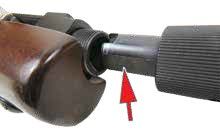
We found it very easy to attach the barrel to the receiver. Just match the flat surface of the chamber end of the barrel to the receiver adapter and tighten the take-down nut. We tightened the take-down nut by hand, or you can tighten it with the supplied spanner wrench. There is a deep groove cut into the take-down nut that fits a coin, which can also be used to tighten the nut. Don’t gorilla the nut. In our opinion, the wrench is not needed. You will just overtighten the barrel and may have issues loosening it. We found the rifle worked well with nut tight or loose.
Shouldering the Papoose, we experienced a more traditional stock and comfort. We found the best way to grasp the rifle with the support hand was to pull the front edge of the stock into our shoulder. We noted the barrel did get warm after extended shooting, but it was still cool enough to touch. We also broke down the rifle and reassembled it several times and found no issue in function or accuracy. The take-down design not only allows for more compact storage, it also made cleaning the rifle easier. We liked the steel-to-steel fit of barrel, receiver, and take-down nut.
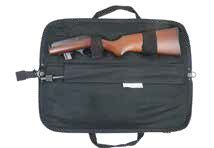
On the range, we found the accuracy of the Model 70P was very good, even if the sights were missing pieces and were doctored. In most instances, we were able to shoot one ragged hole. Our best five-shot group measured 0.32 inches with the 36-grain HP Winchester Xpert HV ammo. The 40-grain LRN Federal Auto Match ammo came in second with an 0.52-inch average group. The CCI Blazer 38-grain LRN ammo gave us a best group that measured 0.58 inches. The Marlin was the most accurate rifle, with average groups that measured 0.47 to 0.72 inches. With a red dot or small optic mounted, we assume we could be even more surgical. We also think the Marlin was the best candidate for an optic because its carrying case offers plenty of room. The trigger-pull weight averaged 5.8 pounds, yet we still punched small groups. During speed shooting, it was easy to control the Papoose and stay on the paper plate.
The lips of the magazine were sharp, so we were careful loading it with our thumbs. Aftermarket magazines are easy to find, such as the ProMag polymer 25-round banana-clip magazine ($18.49; MidwayUSA.com), though steel factory seven- or ten-round magazines are difficult to find. Lack of steel magazines made us down grade the Model 70P.
Our Team Said: The Model 70P had excellent accuracy and was easy to disassemble. We would wait, however, to see if Ruger rolls out a new Papoose. We’d prefer a polymer stock and stainless metal, especially in wet environments. There is also a dearth of seven- or ten-round steel magazines that a re-issue might fix. In fact, having a rotary 10-22 Ruger magazine for this rifle would be awesome.
22 Long Rifle Range Data
| Winchester Xpert HV 36-grain HP | Henry AR-7 | Chiappa Little Badger | Marlin 70P Papoose |
| Average Velocity | 1186 fps | 1266 fps | 1255 fps |
| Muzzle Energy | 112 ft.-lbs. | 128 ft.-lbs. | 126 ft.-lbs. |
| Smallest Group | 0.46 in. | 0.49 in. | 0.32 in. |
| Average Group | 0.53 in. | 0.61 in. | 0.47 in. |
| Federal Auto Match 40-grain LRN | Henry AR-7 | Chiappa Little Badger | Marlin 70P Papoose |
| Average Velocity | 1113 fps | 1222 fps | 1149 fps |
| Muzzle Energy | 110 ft.-lbs. | 133 ft.-lbs. | 115 ft.-lbs. |
| Smallest Group | 0.32 in. | 0.47 in. | 0.52 in. |
| Average Group | 0.34 in. | 0.55 in. | 0.56 in. |
| CCI Blazer 38-grain LRN | Henry AR-7 | Chiappa Little Badger | Marlin 70P Papoose |
| Average Velocity | 1207 fps | 1213 fps | 1249 fps |
| Muzzle Energy | 123 ft.-lbs. | 124 ft.-lbs. | 132 ft.-lbs. |
| Smallest Group | 0.69 in. | 0.51 in. | 0.58 in. |
| Average Group | 0.75 in. | 0.57 in. | 0.72 in. |




























Woah! I’m really loving the template/theme of this blog. It’s simple, yet effective. A lot of times it’s hard to get that “perfect balance” between superb usability and appearance. I must say that you’ve done a great job with this. Additionally, the blog loads very quick for me on Internet explorer. Outstanding Blog!